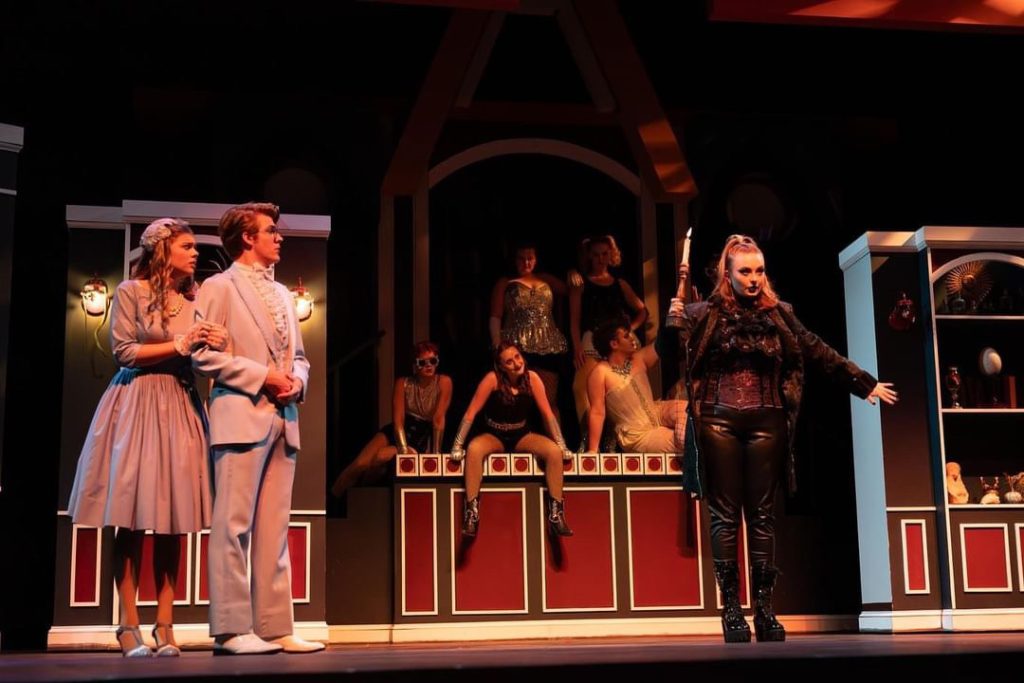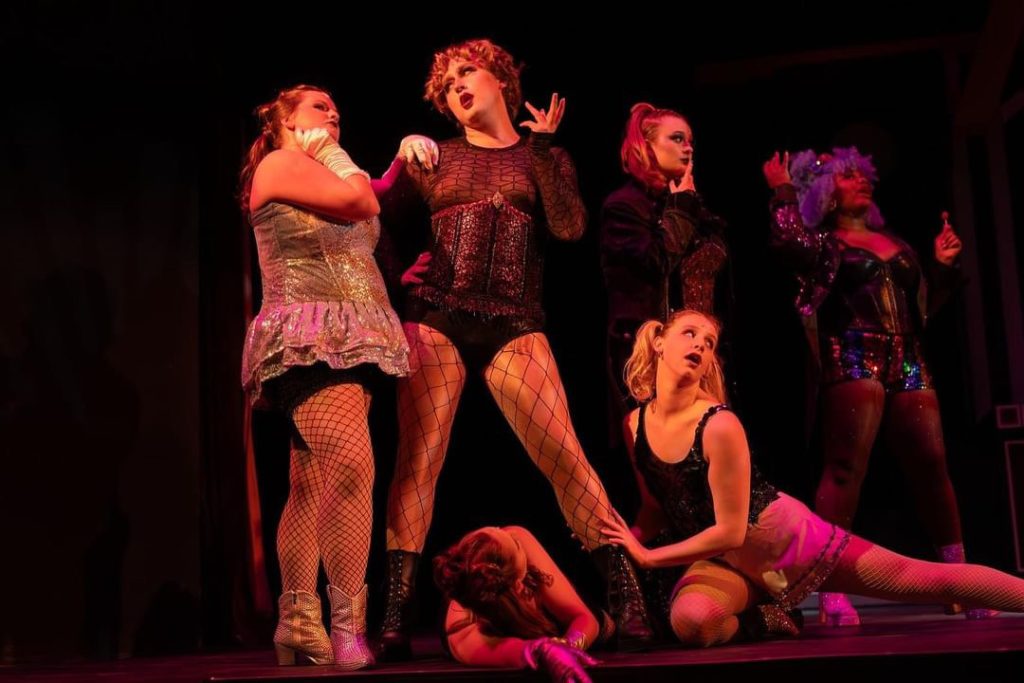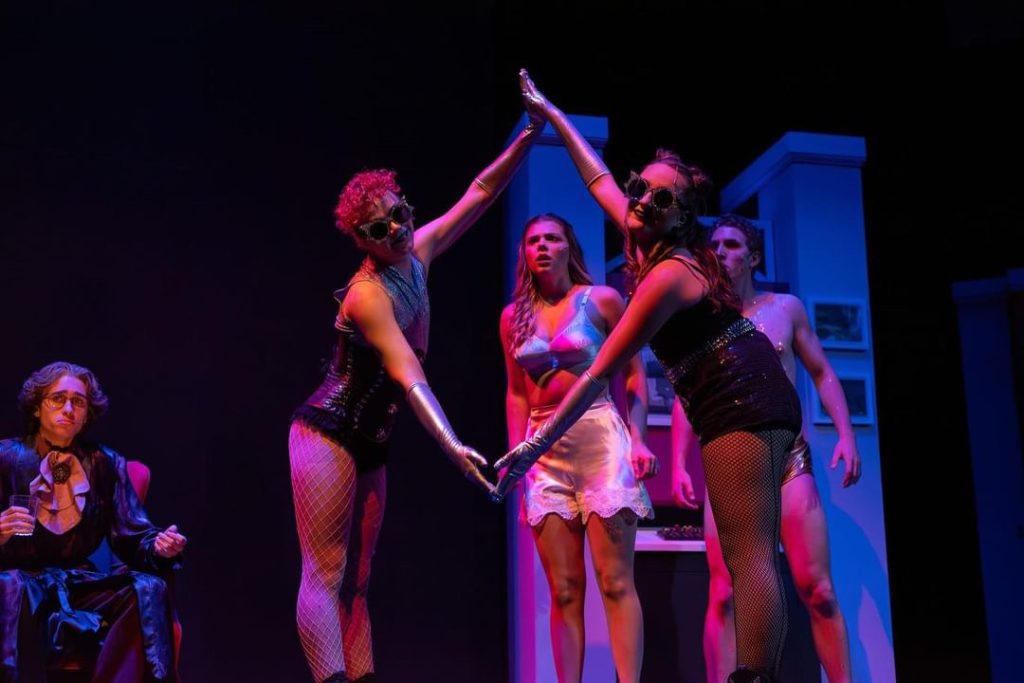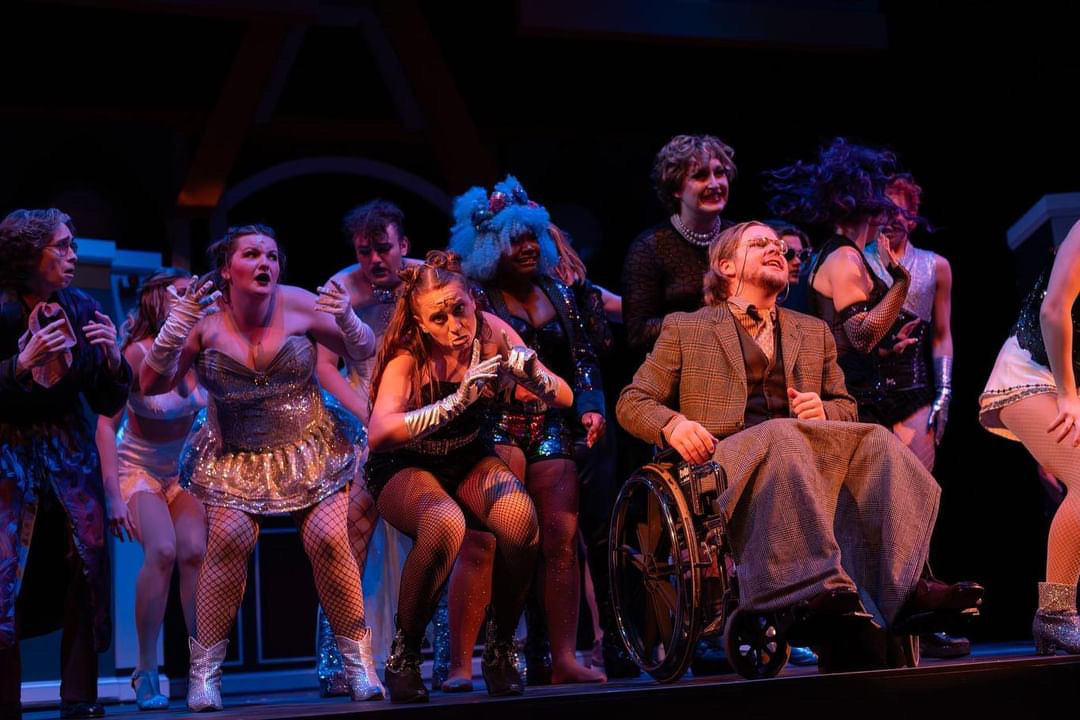Content warning: this article contains strong language.
The University of Alabama Theatre and Dance (UATD) production of The Rocky Horror Show enacted a game between the audience in the seats of the Gallaway and the cast on its stage. With callouts (scripted responses for the audience to shout during the performance) projected onto the walls near the wings alongside prop bags sold at the door, audience participation was encouraged—well, from a distance. Placing the production in the Gallaway Theatre was not the best choice for an audience-driven performance. Being a proscenium space, a picture frame-like separation exists between the actors on stage and the audience. Still, an attempt was made to bridge the gap by implementing three components: projections with audience callouts and instructions, prop bags for an additional fee, and a “Time Warp” UATD donor plant. Taking into consideration contemporary US theatre’s staunch social norms as compared to the rampant involvement of Rocky Horror’s movie counterpart, UATD’s pay-to-play experience waded into the deep between these differing expectations.
One of the most successful elements were the projections and call-outs. As in any participatory setting, it takes some time for audiences to learn the game being asked of them—and unlearn other behaviors. On the night I attended, the audience went from a staggered and unsure “And God said, ‘let there be Usherette!’” to eventually ramping up to a strong, resounding “asshole!” or “slut!”; the momentum and comfort for these callouts had grown as the show had progressed. Despite this progress, it did not seem that the actors had been rehearsed what to do, or how to improv or vamp, in the time it would take audiences to grasp the callouts early on. As the callouts were being introduced at the beginning of the first act, several seconds of dead space lived between lines as the actors waited for the callouts to be recognized, processed, and read aloud by the audience. If the actors had prepped without the callouts, it didn’t show; had the actors relied on each other’s lines without pausing for audience reactions (something one can never be certain of, no matter the prompting), the show would have perhaps felt more genuine.

On the other hand, the prop bags and the donor planted in the audience fell flat. Before the show, UATD ushers encouraged playgoers to spend five dollars on a prop bag up from the moment Rowand-Johnson’s lobby opened until the last minutes before the curtain rose. Each bag contained one folded newspaper page, two glowsticks, one kazoo, one medical glove, and one playing card. The bag itself was a brown paper bag, adorned with a Rocky Horror Show sticker that matched the playbill and attached a small piece of paper with vague instructions for prop usage to the bag. (Participants were not allowed to bring in their own materials.)
In addition to this slip of paper on the bag, the projectors would prompt the use of each prop. To differentiate these instructions from the callouts, prop instructions and other non-callout inserts were surrounded by asterisks. The third musical number, “Over at the Frankenstein Place,” began four separate instances of prop-based audience participation. This song had the most prop use with both the glowsticks and newspaper piece. Despite the vague instructions given on the bag and projected by the wings, audience members were taken by surprise each time a prop was prompted. Regardless of preparation, the props still had to be retrieved from the prop bags, taking several seconds. The bags, as they were made of paper, were quite noisy. The only time this noise was not a distraction was in the number where the props began: “Over at the Frankenstein Place.” During the number, the bags sounded like rain, adding ambience to the scene. In the other prop-bearing situations, however, the rustling of paper bags took me out of the experience and made me focus on the noise of the bags rather than the performance.
The monied or otherwise consumerist emphasis that the compulsory prop bag implied was reinforced by the inclusion of program donors into the performance. Both choices were at odds with the ethos of the counter-cultural Rocky Horror as well as the economic precarity of the presumed intended audience, UA undergraduates. Assisted by Magenta, a group of individuals from the audience who had not been a part of the production until that moment were brought onto the stage near the end of “Time Warp.” As I was sitting in the same section as the donors, I was confused when a group of older people (a seemingly displaced demographic) one or two rows ahead of me rose and started making their way onto the stage. For around thirty seconds to a minute, the donor(s) went onto the stage, did a little dance, and then got off stage (again, assisted by Magenta). This out-of-character safety measure removed me from the theatrical experience as, instead of watching the actors on stage, I was watching the donors, hoping they wouldn’t fall and halt the show. Though I understand the importance of thanking the donors of UATD’s program, having an actor break character to get them on and off stage for a cameo not integrated into the narrative seemed to suggest the monied interest was more important than the art being made.

As I walked out of the theatre and into the cool evening air, the production left me with a compelling question: is audience participation necessary for an “authentic” Rocky Horror experience? Given the long-lived popularity of the film, now with multiple generations having experienced throwing bread or hoisting umbrellas during community screenings, the urge to mix the film and theatrical mediums is understandable as a way to provide an experience that an audience can expect to enjoy. Inviting participation has to make space for a certain amount of flexibility and improvisation, otherwise you run the risk of audiences experiencing dissociation from rather than immersion in the performance. External factors like location, implied etiquette, and audience’s previous experiences with similar media all weigh heavily. Yes, I understand the importance of audience participation with The Rocky Horror Picture Show and how it forms the views of all Rocky Horror media. I also understand—and embrace—the desire to stray from specific theatrical standards, such as limited audience engagement, to create a new and exciting experience. Regardless of each tradition’s norms, UATD’s production of The Rocky Horror Show begs the question: does every production of The Rocky Horror (Picture) Show need to abide by the rules set by one standard over the other? More importantly, does every production of The Rocky Horror (Picture) Show need audience participation?
In this production of Rocky Horror, theatrical and cult-classic traditions collided and fought for dominance. From my perspective, the theatrical traditions overcame the cult-classic nuances to create a jarring mishmash of both sides, as if the rules changed from scene to scene. With this attempt to combine both aspects, I feel like no real median was reached between them. Yes, aspects of both could be seen strongly throughout the production, yet the dominance of keeping to Gallaway and UATD standards shone through the most. I appreciate the desire to be out-of-the-box with this production, but it needed to fully lean into one side or the other to tell a cohesive story. To me, there is no standard for an “authentic” Rocky Horror experience. Each production is unique and does not have to stand by either the theatrical or cult-classic standards. In trying to reach both, the waters got murky, and many other aspects were lost in the depths.

The Rocky Horror Show was directed by Robert Fuson and ran from October 3 to November 5, 2023. The cast included Reilly Durkin (Frank ‘N’ Furter), Hayden Salter (Brad), Carissa Ferguson (Janet), Mekelle Alisse (Columbia), Kaylee McMahan (Riff Raff), Valerie Allen (Magenta/Usherette), Logan Rice (Rocky), Matthew Beutjer (Eddie/Dr. Scott), Cole Pigford (Narrator), Lucas Dixon (Brad Swing/Phantom), Dailey Dodgen (Frank ‘N’ Furter and Eddie/Scott Swing/Phantom), Vander England (Rocky Swing/Narrator Swing/Phantom), Anne Kelly (Magenta Swing/Riff Raff Swing/Phantom), and Lanie Walsh (Columbia Swing/Phantom). The creative team included Searcy Wilemon (stage manger), assisted by Katie Harman, Sophi Rose, and Leigh Baldwin; Matt Stratton (technical director); Fen Kennedy (dramaturgy); Allison Hetzel (dialect coach); Lexi McKay (intimacy choreographer); Sarah Greene (costume design) assisted by Hollan Epsy; Soledad Sanchez (scenic design) assisted by Rebecca Wood; and Regan Ellward (props director).

